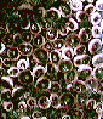Hey all,
I was wondering if anyone here can help me with some mystery IDs.
1. These came on some rock that was picked up in Hawaii, I'm not sure what they are. Maybe some zoos? Anyone know what type?


2. This growth started on my live rock about two or three months ago and has spread very rapidly to cover the front part of this rock and parts of other rocks. I have pulled it off repeatedly but it grows back. It smothered some other zooanthids I have.



Any idea what this is? How can I get rid of it?
Many thanks for these IDs!
--Doug.
I was wondering if anyone here can help me with some mystery IDs.
1. These came on some rock that was picked up in Hawaii, I'm not sure what they are. Maybe some zoos? Anyone know what type?


2. This growth started on my live rock about two or three months ago and has spread very rapidly to cover the front part of this rock and parts of other rocks. I have pulled it off repeatedly but it grows back. It smothered some other zooanthids I have.



Any idea what this is? How can I get rid of it?
Many thanks for these IDs!
--Doug.


